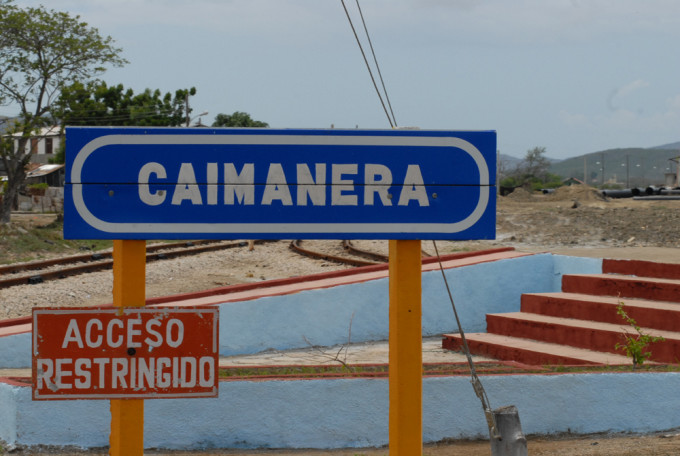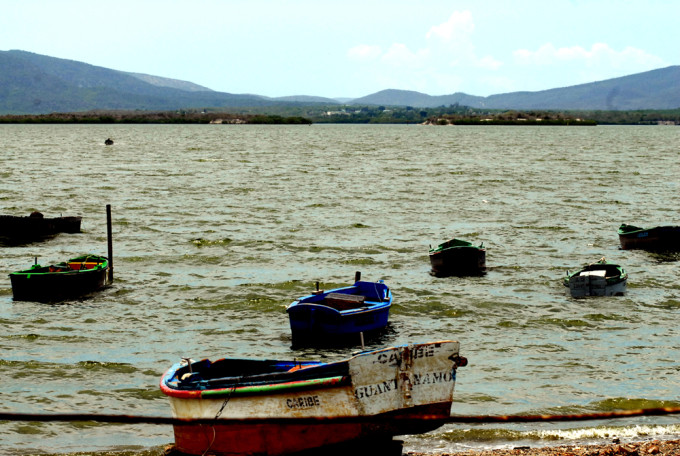‘Coexisting’ with the US Navy base at Guantánamo
HAVANA TIMES – When Raúl Castro repeats, over and again, that his demands for the normalization of relations between Cuba and the United States include the return of the U.S. naval base at Guantánamo Bay, he is asking not just for a piece of land 117.6 square kilometers that belongs to us.
One thousand tales can be told about the years prior to 1959. In the city of Caimanera, say researchers and old men, an entire quarter (now known as El Cañito) serviced the U.S. marines with sexual trade and an entire system of bars, cantinas and cabarets.
The most famous sites were the Number One Coffee, La Plaza, El Oasis, and El Club Naútico, where Benny Moré and Pacho Alonso used to sing.
Caimanera was a generally prosperous city. It is said that at least $12 million poured every year in the region as a result of the visit of U.S. tourists to the city’s elegant stores and to nearby Guantánamo. The wages of the workers at the base added to the revenue.
The bonanza came at a price. There were “tolerance zones” where soliciting was permitted, prostitutes walked the streets, and alcohol was served everywhere to the marines.
But “then came the fury,” tells historian René González Barrios. The marines “fought among themselves, slapped the Cubans around with impunity, broke tables or windows, and walked around in their skivvies.”
Not all their acts were offensive, however. The older residents recall that, in October 1959, two U.S. Navy tugs put down a fire that razed three city blocks and was threatening to wipe out Caimanera.
Today, the American influence continues, even though, for the past half a century, no marine has stepped on Cuban soil beyond the naval base boundaries.
The sea in between
In Caimanera, the sea is not a real sea. Everywhere else, the sea is the end of the land and the start of infinity, but not for a Caimanerense. To him/her, the sea is a void, a space of salt water that doesn’t even resemble the sea we all know, that has a darker, murkier color than the sea.
To a Caimanerense, the sea is just a small beach and a few swim strokes before he enters the forbidden zone, a distance of meters that has been reduced by the years and the illegal defections that, in the 1990s, interrupted the citizens’ sleep with floodlights and macabre sounds.
That’s because every day someone plunged into the sea. Parents and grandparents did not go to bed until each son and grandson had returned home. Their hearts stopped every time a siren sounded or a mine explosion was heard.
Many were arrested. Others leaped into the water just the same but reached the naval base or drowned in the attempt.
Almost always, those who were arrested came from other cities in Guantánamo province or from other provinces, seduced by the nearness between the U.S. territory and Cuba, but unfamiliar with the terrain.
There are many stories that would be funny if they weren’t so grim. Stories of swimmers who came ashore in Boquerón, a town near Caimanera, mistook the lights and the architecture of the Caimanera Hotel and stepped on the beach, kissing the sand and speaking English.
Some chose to jump the fence into the base, tip-toeing around the land mines (Cuban and American) that formed a huge minefield. Many returned to Cuban soil mutilated by the mines or were rescued by Cuban sappers; others managed to cross into U.S. territory, and others were blown to pieces halfway through the trek.
Those who couldn’t finish the crossing were almost always outsiders. Caimanera natives knew the sea and knew that, on certain nights, the current in the center of the bay helped swimmers reach the far shore. But that was in olden days, before the construction of La Pasarela, a barrier of metal and mesh across the water, which many accuse of keeping fish out of the Cuban waterfront.
Fishing has been negatively affected in Caimanera, to the point that fish no longer can be easily plucked from the water. Professional fishermen now have to be satisfied with crab fishing. Many in the local fishing cooperative have been sent to work in Niquero, Granma province.
After the turn of the century, illegal departures to the U.S. base dropped dramatically. All that remains is ghosts, isolation, and a sea that is not the sea but a sort of frontier or a vacuum.
How to live in another world
To live in Caimanera, according to young custodian Aroldo Rojo, is like living in another world that, paradoxically, is barely 23 kilometers from the city of Guantánamo.
To enter Caimanera, you must go through three checkpoints with gradually increasing security demands.
Even if you were born and lived all your life in the city, you need a special permit to enter it. The natives, known as Caimanerenses or Caimaneteros, must carry not only the national identification card but also a pass, with the bearer’s picture and full name, signed by an Interior Ministry official.
For those living in Caimanera, the passes are permanent, though they must be renewed every so often. If the bearer (native or not) moves to another city, the pass is rescinded.
For the rest of Guantanameros the restrictions are tougher, and for many it is impossible to visit Caimanera.
“Living in Caimanera,” Rojo explains, “means being unable to invite outside friends or a girlfriend to spend some time with you. At popular gatherings, you invariable see the same faces, over and again.”
Life there is very boring, says Arturo López, who grew up listening to tales from his grandfather, a brawny carpenter who spent all his money in “the bayous,” as whorehouses were called, and was known as The Golden Arm. Unable to find satisfactory options, López spends most of his time in the city of Guantánamo.
Some years ago, he says, there was “the base,” the TV channel that served the English-speaking population of the Navy zone. Its signal, and that of two radio stations, reached the city of Guantánamo.
Unofficially, “the base” was the Guantanameros’ third TV channel, the others being Cubavisión and Telerebelde. Its presence provided the locals with a constant flow of English language, American pop music, Major League baseball and N.B.A. basketball, in the days of Magic Johnson, Dennis Rodman, Jake O’Donnell and the mythical Michael Jordan, whose moves defied all the laws of physics.
But life goes on. While many left, a lot more stayed, and they expect they will leave their bones in the same place where they were born. Today, Caimanera survives basically from the production of salt. Its people enjoy free health care, zero infant mortality, and an educational system that ranks among the best in the province.
In addition, its inhabitants have certain advantages in terms of wages. Just for working in the area, they are paid 30 percent more than workers elsewhere in the country. Regularly, they receive measured amounts of beef and milk.
City Hall can be reached by railway and bus. Contact with the nearby town of Boquerón is provided by a ferry that runs every day of the week.
Constant fear
To the Caimanerense, the nearness of the U.S. Navy base is also a source of fear. As belligerence grew between the U.S. and Cuba since the very start of the Revolution, the demarcation between the base and Cuban territory became a border between enemy countries.
The list of provocations from the base is long. U.S. servicemen used to cross the fence and walk on Cuban soil, shouting insults and making obscene gestures. They threw everything at the natives, from cigarettes and food to improvised explosive devices and stones. Bullets, too.
Ramón López Peña died of a shot to the neck, 30 minutes after beginning his shift as a guard, on July 19, 1964. The day had begun with guns loaded and insults hurled across the border, a day like all others along that strip of land where — the Americans hoped — a new “Maine” might develop, a pretext for the U.S. to pounce on Cuba.
According to The Cuban People’s Lawsuit to the Government of the United States for Damages and Prejudice, eight Cubans were murdered by the marines and 15 were wounded. Some servicemen, too, but also workers and fishermen.
Caimanera was like a besieged bastion and both Cuban servicemen and civilians suffered the harassment and the shows of force from the U.S. side. The marines would carry out target practice night and day, and U.S. warplanes would engage in maneuvers that could be watched from the city’s homes.
“The pictures on the walls, the decorations on the tables, everything rattled,” Rojo recalls. “There were so many explosions that the buildings’ walls cracked and they remain like that today. We got used to it, but there were days when the noise was excessive and we felt fear, shock.”
The U.S. presence means money to many families, though. Although most of the Cubans who worked at the base were dismissed in 1964 and the U.S. announced two years later that it would not pay them retirement wages, a few years ago the retirement checks started to arrive. This meant an income of thousands of dollars and an improvement in the lives of dozens of Guantanameros and the widows of former base employees.
Meanwhile, somewhere in Havana, someone files away checks for $4,085 each, which arrive every year from Washington, a ridiculously low amount that the United States pays Cuba for the lease of the almost 120 kilometers square of land occupied by the U.S. Navy Base at Guantánamo Bay.
Those checks will apparently continue to arrive, despite Washington’s refusal to hear Cuba’s arguments for the land’s return and the closing of the prison for alleged Arab terrorists. They will continue to arrive, despite the recent statements of President Obama and Secretary of State John Kerry about a reestablishment of bilateral relations. Life goes on.
[Photos: Caimanera / Lorenzo Crespo Silveira. From his blog ‘Desde este lado de la isla’ — ‘From this side of the island.’]













Close it down,and send them back all uncashed cheques for so-called land lease…
Not open to negotiation, return Guantanamo or leave us alone!
The base has been American soil for 100 years. Eventually the Americans will make a better deal. But they are not giving it back. Why would they ?
Give it back. It does not serve the original purpose of the lease. Or, work out another deal by cutting the size of the base and paying much more for the lease. How would the U.S. feel if a foreign government had a military base on our soil. The lease dates back to the late 1800’s as part of the Platt Amendment.